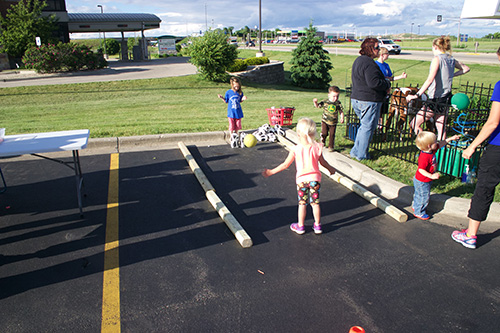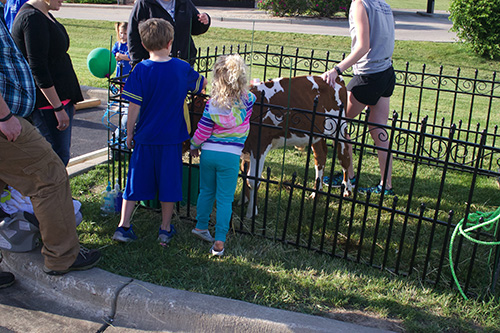Take the farm to the people, instead of taking the people to the farm.
![]() June Dairy month brings excitement as the public sets foot on real dairies during dairy breakfasts and tours. They introduce, or reintroduce, consumers to modern dairy farming. However, consumers need to travel to those events. What if logistics in your farming community are not suited for these events?
June Dairy month brings excitement as the public sets foot on real dairies during dairy breakfasts and tours. They introduce, or reintroduce, consumers to modern dairy farming. However, consumers need to travel to those events. What if logistics in your farming community are not suited for these events?
A few days ago I went to one of my favorite eating establishments, Culver's. A dairy promotion event was organized by local dairy youth, "Culver's and Cows." A portion of the proceeds from their famous ButterBurgers, shakes, and custard (actually all menu items) was donated to the group. The dairy youth helped deliver the food to the patrons' tables while Scoopie, the Culver's mascot, walked around waving and high-fiving kids.
Outside, there was a calf to pet, dairy drawings to color, and milk jug bowling. Young people were on hand to answer questions about dairy farming. Adults were also there to assist were needed.
While not every town has a Culver's, there are other places where residents would frequently visit. A calf at the bank, outside the supermarket, the public library, or an outdoor shopping mall would draw attention to dairy farming in these very public places.

Events require advanced planning and a good relationship with the manager of the location. But if you never ask, the answer is always "no."
In grammar school, my class had a field trip to our dairy. I gave the tour. (I was not a talker in school, but I wanted to share everything when I was on the farm). They were served milk with lunch and ice cream for dessert. From my classmates' letters, they had a great time.
The logistics did not work when I wanted to host my classmates a few years later. Dad's compromise was to take a cow and calf to school for my 4th grade classmates. It was my first year in 4-H, so I had plenty to share with them.

While it was not the same as having them on the farm, it was still an opportunity to connect dairy farming to the faces on the farm. They quickly learned that milk just does not come from the store – it starts with cows and the people who care for them.
I bet if you took a poll of those classmates three decades removed from their "dairy exposure," they'd still be able to reminisce about what they learned or what they saw.

The author is the online media manager and is responsible for the website, webinars and social media. A graduate of Modesto Junior College and Fresno State, she was raised on a California dairy and frequently blogs on youth programs and consumer issues.
A few days ago I went to one of my favorite eating establishments, Culver's. A dairy promotion event was organized by local dairy youth, "Culver's and Cows." A portion of the proceeds from their famous ButterBurgers, shakes, and custard (actually all menu items) was donated to the group. The dairy youth helped deliver the food to the patrons' tables while Scoopie, the Culver's mascot, walked around waving and high-fiving kids.
Outside, there was a calf to pet, dairy drawings to color, and milk jug bowling. Young people were on hand to answer questions about dairy farming. Adults were also there to assist were needed.
While not every town has a Culver's, there are other places where residents would frequently visit. A calf at the bank, outside the supermarket, the public library, or an outdoor shopping mall would draw attention to dairy farming in these very public places.

Events require advanced planning and a good relationship with the manager of the location. But if you never ask, the answer is always "no."
In grammar school, my class had a field trip to our dairy. I gave the tour. (I was not a talker in school, but I wanted to share everything when I was on the farm). They were served milk with lunch and ice cream for dessert. From my classmates' letters, they had a great time.
The logistics did not work when I wanted to host my classmates a few years later. Dad's compromise was to take a cow and calf to school for my 4th grade classmates. It was my first year in 4-H, so I had plenty to share with them.

While it was not the same as having them on the farm, it was still an opportunity to connect dairy farming to the faces on the farm. They quickly learned that milk just does not come from the store – it starts with cows and the people who care for them.
I bet if you took a poll of those classmates three decades removed from their "dairy exposure," they'd still be able to reminisce about what they learned or what they saw.

The author is the online media manager and is responsible for the website, webinars and social media. A graduate of Modesto Junior College and Fresno State, she was raised on a California dairy and frequently blogs on youth programs and consumer issues.








